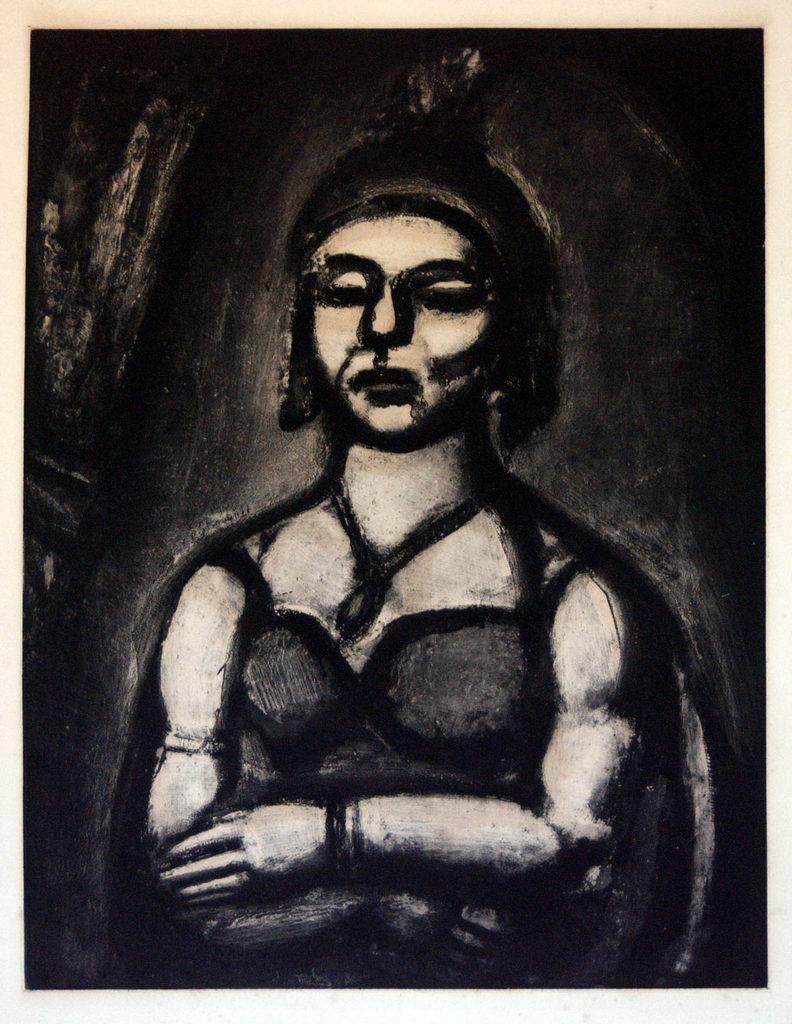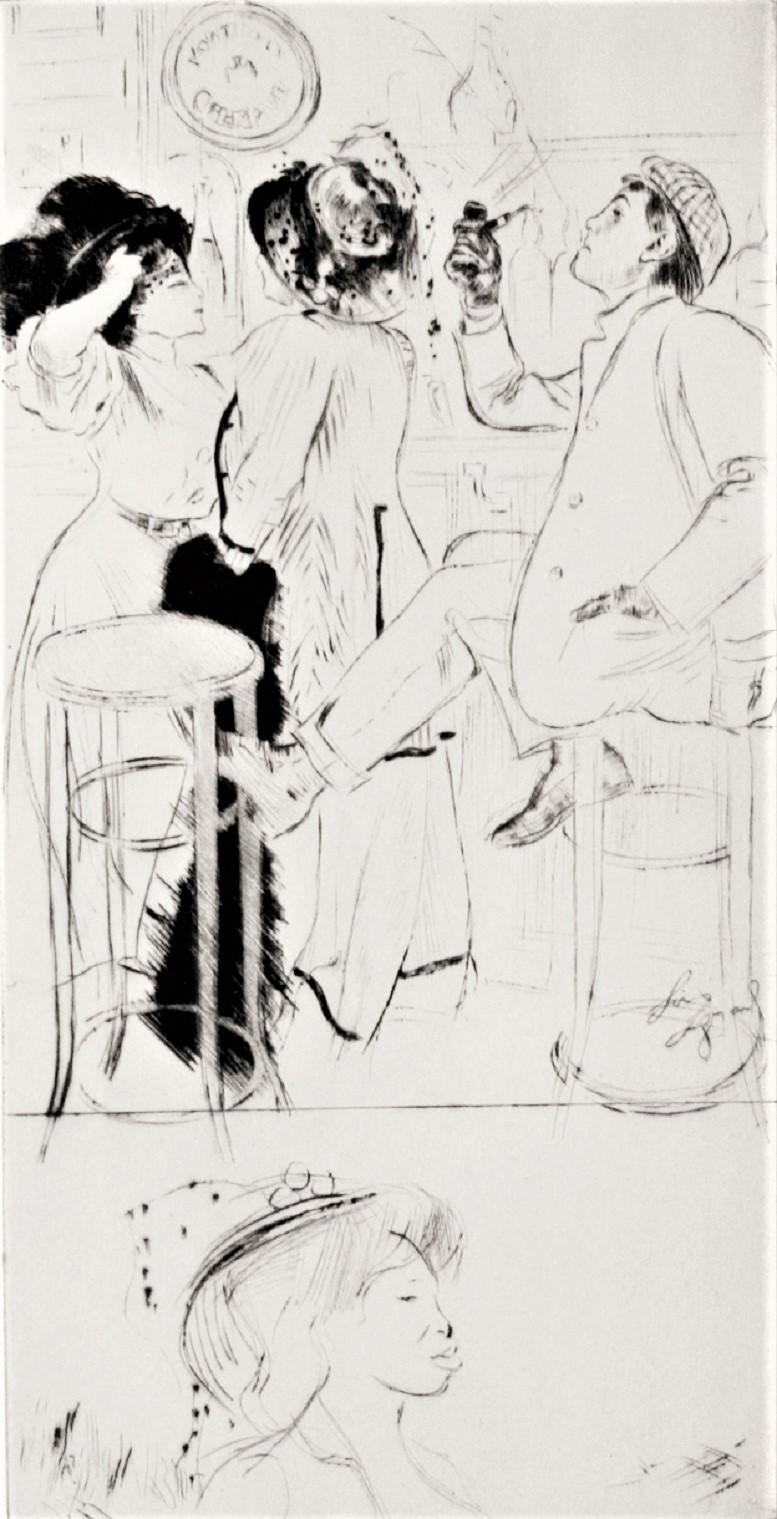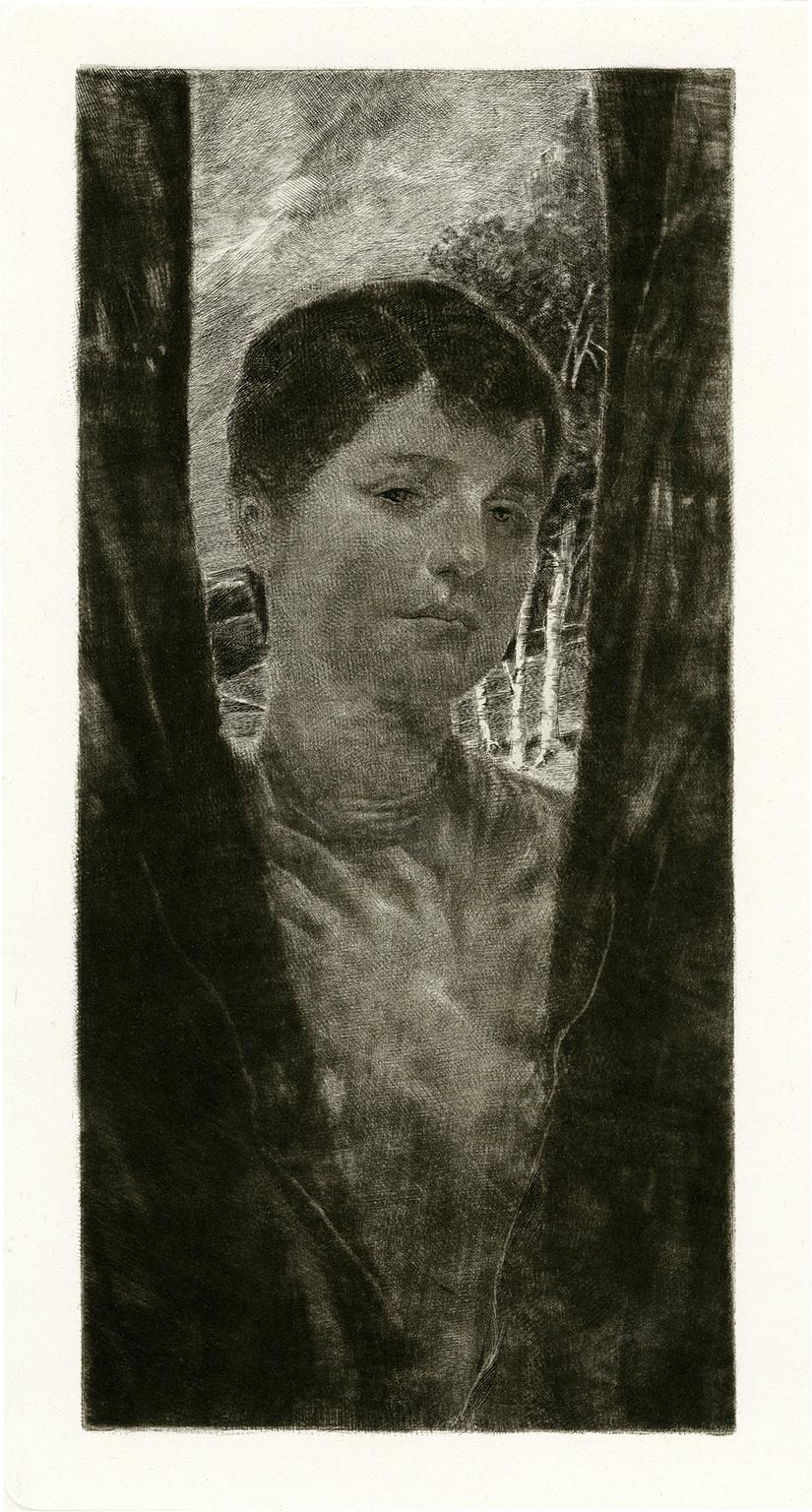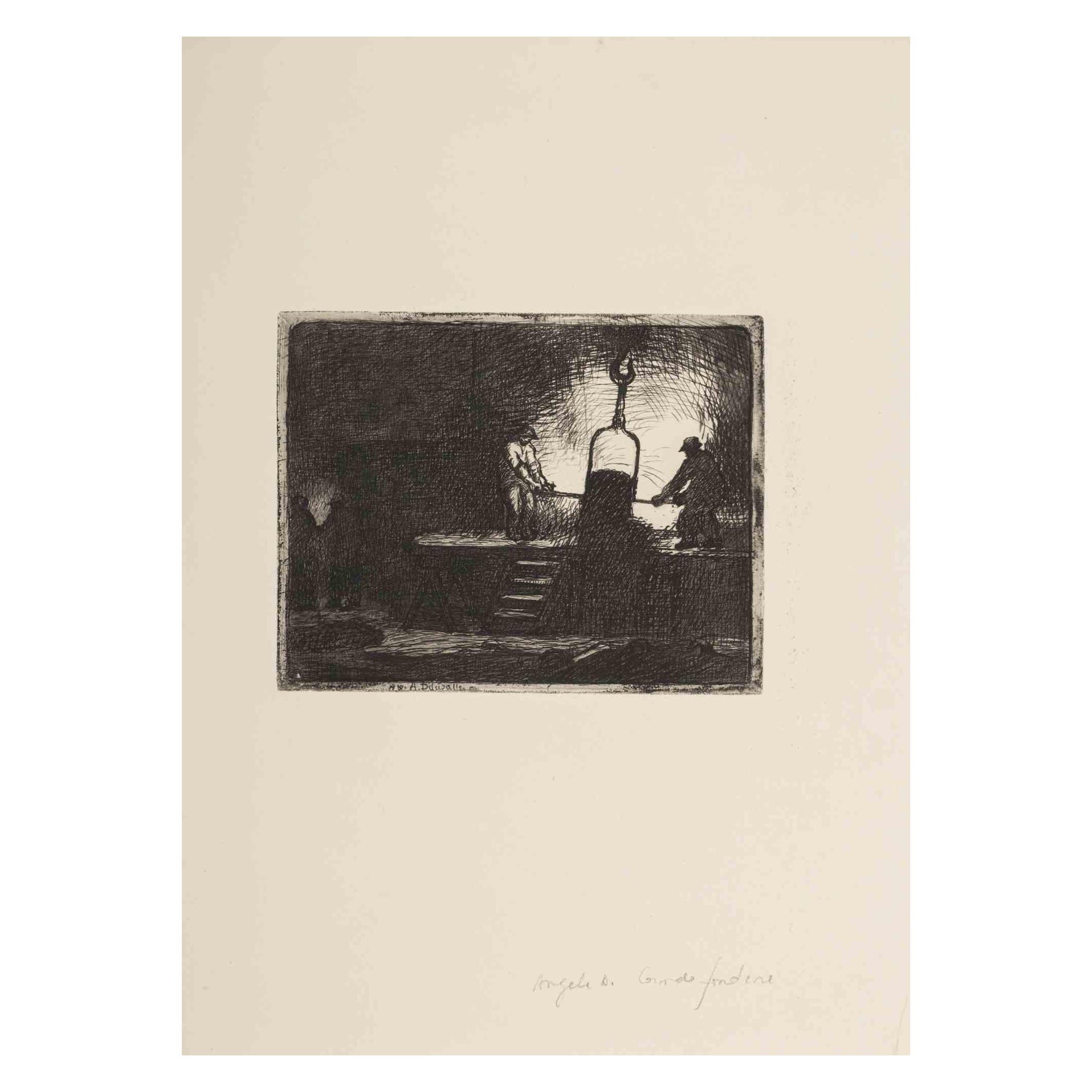Lelia PissarroCharlotte and Amalia by Lélia Pissarro - Etchingcirca 1995
circa 1995
About the Item
- Creator:Lelia Pissarro (1963, French)
- Creation Year:circa 1995
- Dimensions:Height: 8.94 in (22.7 cm)Width: 10.83 in (27.5 cm)
- Medium:
- Movement & Style:
- Period:
- Condition:
- Gallery Location:London, GB
- Reference Number:1stDibs: LU261213093382
Lelia Pissarro
Lélia Pissarro was born in Paris on the 27th of July in 1963, the third and youngest child of the artist Hugues-Claude Pissarro and Katia, an art dealer.
From infancy until the age of 11 Lélia was entrusted to the care of her grandparents, Paulémile Pissarro and his wife Yvonne, and her interest in drawing and painting was nurtured by Paulémile whilst living in Clécy, Normandy. Paulémile taught her the fundamental Impressionist and Post-Impressionist techniques as had been taught to him by his father and his brothers, and so began her love for figurative art. She sold her first canvas to Wally Findlay, a New York art dealer, when she was only four years of age!
Before his death, Paulémile made Lélia promise to retain her family name, to continue painting and to make art her life.
At the age of 11, Lélia returned to Paris to live with her parents and it was then that she had her first exhibition at the "Salon de la Jeune Peinture" where she was, in all probability, the youngest ever exhibitor.
Hugues-Claude, whose style veered towards conceptual art, took over from Paulémile as Lélia’s teacher and consequently she practiced drawing on a daily basis.
At 15 Lélia participated in an exhibition at the Luxembourg Museum in Paris and a year later, having excelled in a special examination, enrolled at the Ecole des Beaux-Arts in Tours. With her parents dividing their time between France and California, Lélia found herself moving between Tours, Paris and San Francisco.
During this period Lélia became dissatisfied with conceptual art and reverted to the family's traditional creative roots, which distanced her from her avant-garde teachers. However, during the late 1980s, as the figurative style once again became fashionable, Lélia’s work gained in popularity.
Whilst in Paris, Lélia taught art at the Moria School and studied oil painting restoration under Madame De Pangalleria at the laboratory of the Louvre and during this time had solo exhibitions in Paris, Lyon, Mulhouse and Rennes.
Following her marriage in 1988 to David Stern, the London art dealer, she moved to London, where her studio has become a meeting place for artists and friends and where conversation and tuition generate an exchange of opinions on drawings, pastels, watercolours, oil paintings and engravings.
In 1999 Lélia became one of the founders of the “Sorteval Press,” a group of artists dedicated to developing their skills and techniques in etching and printmaking. Their first exhibition took place at the Mall Gallery in London, and the artists’ efforts ensured a highly successful first exhibition.
Balancing her role as artist and mother to three children, Lélia has successfully exhibited not only in London but also in Japan, South Africa, France, Switzerland and Israel. In the United States, Lélia's work has been shown in New York, Boston, Washington D.C., Dallas, San Francisco and Los Angeles.
Following the tradition of her great-grandfather Camille Pissarro, her grand-father Paulémile and her father Hugues-Claude, this fourth-generation artist has played an important role by participating in a series of exhibitions entitled “Pissarro — The Four Generations.”
(Biography provided by Stern Pissarro Gallery)
- ShippingRetrieving quote...Ships From: London, United Kingdom
- Return PolicyA return for this item may be initiated within 7 days of delivery.
- Horse Pulling Hay Cart by Félix Pissarro - Animal etchingBy Félix PissarroLocated in London, GBHorse Pulling Hay Cart by Félix Pissarro (1874-1897) Etching 19.5 x 15 cm (7 ⅝ x 5 ⅞ inches) Exhibition London, Stern Pissarro Gallery, Camille Pissarro & hi...Category
1890s Post-Impressionist Animal Prints
MaterialsEtching
- Rupert Rides by Orovida Pissarro - Animal etchingBy Orovida PissarroLocated in London, GB*UK BUYERS WILL PAY AN ADDITIONAL 20% VAT ON TOP OF THE ABOVE PRICE Rupert Rides by Orovida Pissarro (1893-1968) Etching 31 x 23.5 cm (12 ¼ x 9 ¼ inches) Signed and dated lower righ...Category
1950s Post-Impressionist Animal Prints
MaterialsEtching
- Curves by Orovida Pissarro, 1919 - Etching PrintBy Orovida PissarroLocated in London, GBCurves by Orovida Pissarro (1893 - 1968) Etching, trial proof no. 54 20.2 x 15 cm (8 x 5 ⅞ inches) Signed and dated lower right, Orovida 1919 Inscribed lower left Trial proof no. 54 ...Category
1910s Post-Impressionist Animal Prints
MaterialsPaper, Etching
- Chatter by Orovida Pissarro - EtchingBy Orovida PissarroLocated in London, GBChatter by Orovida Pissarro (1893-1968) Etching 26 x 19 cm (10 ¹/₄ x 7 ¹/₂ inches) Signed and dated lower right Orovida 1927 Inscribed lower left Trial proof no. 18/25 and titled lower middle Artist biography: Orovida Camille Pissarro, Lucien and Esther Pissarro’s only child, was the first woman in the Pissarro family as well as the first of her generation to become an artist. Born in Epping, England in 1893, she lived and worked predominantly in London where she became a prominent member of several British arts clubs and societies. She first learned to paint in the Impressionist style of her father, but after a brief period of formal study with Walter Sickert in 1913 she renounced formal art schooling. Throughout her career, Orovida always remained outside of any mainstream British art movements. Much to Lucien's disappointment she soon turned away from naturalistic painting and developed her own unusual style combining elements of Japanese, Chinese, Persian and Indian art. Her rejection of Impressionism, which for the Pissarro family had become a way of life, together with the simultaneous decision to drop her famous last name and simply use Orovida as a ‘nom de peintre’, reflected a deep desire for independence and distance from the weight of the family legacy. Orovida's most distinctive and notable works were produced from the period of 1919 to 1939 using her own homemade egg tempera applied in thin, delicate washes to silk, linen or paper and sometimes embellished with brocade borders. These elegant and richly decorative works generally depict Eastern, Asian and African subjects, such as Mongolian horse...Category
1920s Post-Impressionist Figurative Prints
MaterialsEtching
- Man & Beast by Orovida Pissarro - EtchingBy Orovida PissarroLocated in London, GB*UK BUYERS WILL PAY AN ADDITIONAL 20% VAT ON TOP OF THE ABOVE PRICE Man & Beast by Orovida Pissarro (1893-1968) Etching 27 x 22 cm (10 ⁵/₈ x 8 ⁵/₈ inches) Signed and dated lower right, orovida 1924 Inscribed lower left, Final state no 12/40 and titled lower centre Artist biography: Orovida Camille Pissarro, Lucien and Esther Pissarro’s only child, was the first woman in the Pissarro family as well as the first of her generation to become an artist. Born in Epping, England in 1893, she lived and worked predominantly in London where she became a prominent member of several British arts clubs and societies. She first learned to paint in the Impressionist style of her father, but after a brief period of formal study with Walter Sickert in 1913 she renounced formal art schooling. Throughout her career, Orovida always remained outside of any mainstream British art movements. Much to Lucien's disappointment she soon turned away from naturalistic painting and developed her own unusual style combining elements of Japanese, Chinese, Persian and Indian art. Her rejection of Impressionism, which for the Pissarro family had become a way of life, together with the simultaneous decision to drop her famous last name and simply use Orovida as a ‘nom de peintre’, reflected a deep desire for independence and distance from the weight of the family legacy. Orovida's most distinctive and notable works were produced from the period of 1919 to 1939 using her own homemade egg tempera applied in thin, delicate washes to silk, linen or paper and sometimes embellished with brocade borders. These elegant and richly decorative works generally depict Eastern, Asian and African subjects, such as Mongolian horse...Category
1920s Post-Impressionist Animal Prints
MaterialsEtching
- Les Poules de Lyora by Lélia Pissarro - Etching and watercolour on paperBy Lelia PissarroLocated in London, GBLes Poules de Lyora by Lélia Pissarro (b. 1963) Drypoint and watercolour on paper 21.5 x 26.5 cm (8 ¹/₂ x 10 ³/₈ inches) Signed lower left, Lélia Pissarro Numbered lower right, 10/15...Category
21st Century and Contemporary Post-Impressionist Figurative Prints
MaterialsPaper, Watercolor, Drypoint
- Des Ongles Et Du BecBy Georges RouaultLocated in Roma, ITEdition of 450 prints, belonging to the suite “Miserere”, considered as the most important religious graphic work of XX century. The single prints, realized with a sophisticated mixe...Category
1940s Post-Impressionist Figurative Prints
MaterialsEtching
- Au Bois de Boulogne - Original Etching by H. Farge - Mid 20th CenturyLocated in Roma, ITImage dimensions: 16 x 11 cm. Au Bois de Boulogne is an original modern artwork realized in the first decades of the XX Century by the French artist Henri Farge...Category
Mid-20th Century Post-Impressionist Figurative Prints
MaterialsEtching
- L’Ane - Original Etching and Aquatint by G. Rouault - 1927By Georges RouaultLocated in Roma, ITL’Ane is an original lithograph, realized by Georges Rouault in 1927, hand signed, Ambroise Vollard's stamp, trial proof of the first state, printed in 10 copies. Included a frame. In very good conditions. The artwork demonstrates a man-donkey creature dressed in suit formally and with a glasses. Georges Henri Rouault (1871-1958) was a French painter, print-maker artist, his artworks are often associated with Fauvism and Expressionism. He is well-known for paintings dedicated to courts, clowns and prostitutes. He was inspired by spirituality and knowledge of medieval stained glass...Category
1920s Post-Impressionist Figurative Prints
MaterialsAquatint, Etching
- SportsmenBy Louis LegrandLocated in Storrs, CTSportsmen. 1908. Etching and drypoint. Exsteens 271.i/ii. 11 1/4 x 5 3/4 (sheet 17 3/8 x 12 1/4). Series: Les Bars. From the first state edition of 30 proofs with the remarque sketch...Category
Early 1900s Post-Impressionist Figurative Prints
MaterialsDrypoint, Etching
- Erinnerung (Remembrance) — Turn-of-the Century Romantic EtchingBy Max KlingerLocated in Myrtle Beach, SCMax Klinger, 'Erinnerung (Remembrance)', etching and aquatint, 1896. A fine, richly inked impression, on off white, wove paper, with full margins (1 3/4 to 3 1/8 inches), in excellen...Category
1890s Post-Impressionist Figurative Prints
MaterialsAquatint, Etching
- Working - Original Etching by A. Delasalle - Mid-20th CenturyBy Angèle DelasalleLocated in Roma, ITWorking is a contemporary artwork realized by the French artist Angèle Delasalle in the Mid-20th Century. Original etching and drypoint. Signed and ...Category
Mid-20th Century Post-Impressionist Figurative Prints
MaterialsEtching






